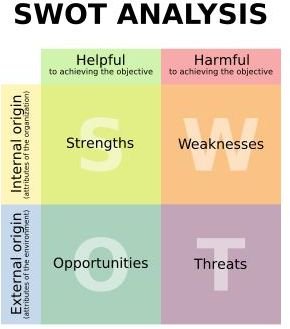Free SWOT Analysis Template for Project Managers
What Is a SWOT Analysis?
The acronym SWOT stands for strengths, weaknesses, opportunities, and threats your project may face. By analyzing each of these 4 elements and performing a SWOT analysis, you can come up with solutions to elements harming your projects. You will also be able to look at elements that are positive (strengths and opportunities) and expand on those positives to enhance project success.
Completing a SWOT Analysis
Before we discuss how to complete a SWOT analysis, first download the free SWOT analysis template found in our Media Gallery. In addition, the Small Business Administration offers a great SWOT analysis example right from their website.
A SWOT analysis falls under the category of strategic business planning—or looking at trends to weed out the negatives in your projects and boost the positives of your project management. In order for you to understand those positives and negatives, they first have to be identified right? This is where the SWOT analysis comes in.
In our free SWOT analysis template, you’ll see they are designed in a four-square block—you can even do this with paper and a pencil! Each of the four blocks contains one of the 4 elements of the acronym SWOT.
Along with those elements and spaces for identifying the good and the bad (or the needed) are sample criteria questions like looking at competitors, business capabilities, resources, knowledge, and even the demographics of the project at hand.
Although our example offers many sets of criteria, you can modify the template to fit the areas you want to explore through your SWOT analysis.
Image Credit (Google Images)
Example of a SWOT Analysis
If we use our free SWOT template, let’s see how we might perform a simple analysis. Let’s say the project is to open a new ice cream parlor for a client.
- Strengths – Here you might identify strengths such as the local market doesn’t have an ice cream parlor nearby—an important strength. Another strength could be the business owner or partner’s prior experience in owning and operating (or even working in) the ice cream parlor industry. Strengths could also be what items will be new and innovative about the new business that competitors haven’t approached.
- Weaknesses – A weakness could also be where the owners of the business have no experience in the ice cream parlor business. Or, lack of funds or capital.
- Opportunities – These could include a possible franchise (think 32 flavors here), potential investors approached with the client’s business plan, sales volumes due to no ice cream parlors in the area, seasonal revenues and uniqueness.
- Threats – Consider the economy, seasonal issues, competitor’s ideas and business models as threats that could deter the business. A potential franchise business could also be a threat if it’s expensive and the client doesn’t have the needed capital.
Remember that any of these 4 elements in your SWOT analysis could be industry specific, so don’t forget those!
Analyzing & Using the SWOT

The most important part of this strategic planning tool is to be honest about every strength, weakness, opportunities and threat—and research them—and be able to back up that research. Simply guesstimating what these 4 elements are will not provide an accurate SWOT analysis.
Once you’ve done the work and used our free SWOT analysis template, you’ll have the both the positives and the negatives identified. From there, a great sister tool to the SWOT analysis is to use a whiteboard and mind mapping techniques to show what could be changed, improved or implemented to make the project a success—mind maps are great in brainstorming sessions.
The key to a good SWOT analysis is obviously doing some homework and really analyzing the areas to overcome challenges and to determine if a project is a good or bad idea, if things can change or improve its success and if the project is even feasible.
Image Credit (FreeDigitalPhotos)
